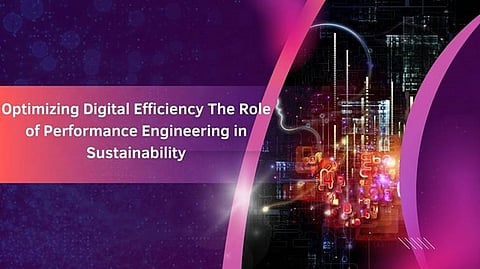

In today’s fast-evolving business landscape, as the demand for digital services grows, so does the environmental impact of computing. Performance engineering, a discipline traditionally focused on improving software efficiency, is now playing a crucial role in reducing carbon footprints across IT infrastructures. Prakash Ramesh, an expert in this field, explores the intersection of computational optimization and environmental sustainability in his latest research.
Modern data centers and IT operations consume massive energy, with global usage expected to rise significantly. Without intervention, data center energy consumption could nearly triple in the coming years. Performance engineering provides a solution by optimizing resource utilization, minimizing waste, and improving efficiency. By implementing smarter computing practices, organizations can reduce environmental impact while maintaining high performance. As demand for digital services grows, sustainable computing strategies are essential to curbing energy consumption and mitigating the environmental cost of computing.
Enhancing algorithmic efficiency is key to reducing energy consumption. Optimized algorithms lower computational complexity, minimizing processing power demands. Techniques like memoization, which reuse previously computed results, significantly cut energy usage. Efficient memory management and compiler optimizations further refine execution, ensuring minimal power consumption.
By streamlining data access and reducing redundant computations, software operates more efficiently, extending battery life in portable devices and lowering overall energy costs. These improvements not only boost performance but also contribute to sustainable computing, making energy-efficient software development a critical aspect of modern technology and system optimization.
Optimizing hardware utilization is crucial for reducing energy waste in IT systems. Many servers run at low capacity, leading to inefficiencies and excessive power consumption. Virtualization and workload consolidation help maximize server utilization, minimizing the need for additional physical hardware. By efficiently distributing workloads, organizations can lower operational costs and environmental impact. Additionally, dynamic power management techniques adjust performance levels based on demand, further reducing unnecessary energy usage.
These strategies enhance efficiency, extend hardware lifespan, and contribute to sustainable IT practices. Adopting such approaches ensures better resource management while maintaining performance and reliability in modern computing environments.
Storage and networking optimization are two avenues that lead to a reduction in the amount of power consumed at data centers. In conjunction with advanced storage technologies, such as data deduplication to remove redundant data, storage becomes minimized and energy efficiency maximized. The tiered storage strategy serves to further bolster efficiency by moving infrequently accessed data onto low-power systems to save energy while allowing for user access. Network-side optimization involves traffic optimization and a content delivery network (CDN) for distributing content efficiently and thereby preventing redundant transfers, reducing overall bandwidth usage.
This improvement not only lowers the energy footprint of digital communications but also enhances system performance and reliability. By employing these techniques, organizations will realize sustainable and cost-effective business operations without degrading data availability or network speed.
Advanced optimization of resources is one of the ways cloud computing can improve energy efficiency. Things like dynamic resource allocations measure computing power depending on real-time demand. This measure thwarts overprovisioning. A lot of monitoring in predictive scaling includes using an AI-controlled facility: it monitors and analyses usage patterns in the past, also those from an application's lifetime, then gives forecasts on how and when workloads will peak and allow reducing wasted energy. Serverless computing is an additional feature helping energy efficiency because resources are used only when required thus eliminating costs of idle infrastructure. Lastly, it schedules workloads to execute tasks that are not necessarily time-critical either in off-peak hours or with high levels of renewable energy availability.
Such techniques map out the carbon footprint within the maximum sustainability. By integrating all of these, organizations will exercise the efficacy of their cloud resources economizing operational costs as well as help green computing efforts. In this way, the adoption of clouds turns out to be cheaper yet also more environmentally responsible.
However, to achieve and maintain these efficiencies, an organization must have good energy monitoring and profiling tools. Metrics such as Energy Usage Effectiveness (EUE) and Carbon Usage Effectiveness (CUE) provide good insight into consumption trends. Sophisticated dashboards and real-time monitoring will allow IT staff to discover inefficiencies and make more effective optimizations. Continued analysis of energy use allows companies to become more sustainable, reduce energy costs, and enhance operational performance in general. This becomes a proactive decision-making approach, November organization would have embedded improved long-term energy efficiency and environmental responsibility as part of its culture.
Performance engineering is a continuous refinement rather than a one-off activity. Automated performance testing, efficiency evaluations, and iterative software enhancements help in maintaining energy efficiency on a perpetual basis. The integration of these measures allows businesses to keep their operational costs low and help in establishing a more sustainable future for the digital world.
To conclude, in tandem with the development of the digital world, performance engineering has become increasingly critical in meeting sustainability goals. These measures will allow organizations to introduce large-scale optimization of software, hardware, and cloud resources to drastically lower their carbon footprint. Prakash Ramesh’s work indicates the necessity of adopting a total view of performance engineering, where efficiency becomes the propeller of environmental responsibility. Advancements in this area will have to be pushed further to ensure a balance between technological expansion and ecological sustainability in the future.
